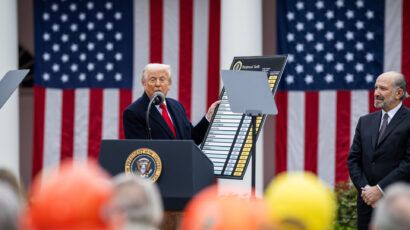Make China great again? How Trump’s attacks on universities will backfire
By Andrew Dessler | April 18, 2025
 Slashing overhead funding for research universities could end up effectively terminating cutting edge research—in the United States at least. (Photo by Diane Serik on Unsplash)
Slashing overhead funding for research universities could end up effectively terminating cutting edge research—in the United States at least. (Photo by Diane Serik on Unsplash)
There’s an important battle brewing over university overhead rates. Sounds boring, right? But hang with me and you’ll see why this is so crucially important to America. It will determine whether breakthrough technologies emerge in American labs or Chinese ones.
Last week, the Department of Energy slashed university overhead rates to 15 percent. They claim this saves taxpayers $405 million annually while ensuring funds support “support scientific research—not foot the bill for administrative costs and facility upgrades.” This is dangerously misleading.
To understand why, let me start by explaining what “overhead” means. When you picture a university research lab, you probably imagine scientists in lab coats, surrounded by high-tech equipment, performing groundbreaking experiments. What you see in this mental image are what we would call “direct costs”—things that are directly involved in a research project.
What you don’t see are the countless support systems making that research possible. Air conditioning, electricity for lighting, wifi, janitorial services, administrative support for payroll and purchasing, and a million other things that cannot be neatly assigned to a particular research project but without which research cannot be done.
These costs are what go into “overhead” and they fall into two main categories. First are shared, distributed expenses spread across the entire research enterprise that would be impossible or absurdly inefficient to track project-by-project: think HVAC systems, IT support, building maintenance, administrative staff processing grants, library resources, and safety training.
Trying to determine how many kilowatt-hours each of the 300 experiments running in a building consumed, or what percentage of the university’s toilet paper expense should be charged to a specific project would be a bureaucratic nightmare.
Second are long-term investments that must be spread over many years: constructing laboratory spaces for faculty, building office space and classrooms for graduate students, building core research facilities, and upgrading infrastructure.
When a university recruits a promising new scientist, they might invest millions in building out lab space before that researcher has even secured their first grant. These costs should be recovered gradually over time.
At Texas A&M University, our overhead rate is 54 percent. Thus, for a hypothetical proposal with $100,000 in direct research costs (salaries, supplies, equipment), an additional $54,000 is requested to support the overhead that makes that research possible. So the total cost to the government for this work would be $154,000. This is comparable to other research universities, which generally have overhead rates between 50 and 70 percent.
This rate isn’t arbitrary. It’s negotiated with the federal government through a rigorous process where A&M had to justify the costs going into the overhead rate to ensure it reflects the actual costs of research.
The Department of Energy’s 15 percent cap will blow a hole in universities’ finances. There are three ways universities could respond.
First, university departments could explicitly include these costs in grant proposals. Imagine future research proposals where we must specify line items for “fraction of janitorial expenses,” “fraction of elevator maintenance,” or “fraction of wifi” used by a particular project.
Right now, such expenses would be prohibited because they are already covered by overhead. If the US government allows, however, those restrictions could be relaxed in response to overhead being cut. However, this approach would be comically inefficient. The administrative burden will increase costs overall, not reduce them. Science will slow to a crawl as researchers become part-time accountants.
Second, universities could find another source of money to cover these costs. But money needs to come from somewhere, and Texas A&M doesn’t have a pile of it sitting around waiting to be spent.
The only real options are through tuition increases or state appropriations. But this fundamentally misunderstands the value of federally funded research. University research benefits the entire nation—creating new technologies, advancing healthcare, strengthening national security, and maintaining America’s competitive edge. Students shouldn’t bear this cost through higher tuition, nor should individual states subsidize what is clearly a national asset.
Third, universities could stop conducting DOE research. When each DOE grant becomes a financial liability rather than an asset, institutions will simply pull the plug. I worry that this will be the approach universities take.
If so, it won’t eliminate research; it will simply relocate it. Improvements in battery technologies, innovations in nuclear and renewable energy, and advances in other related fields will still happen, just not in America.
China, Europe, and other regions with rational research funding models will happily fill the void. Ultimately, in the name of saving 0.006 percent of the federal budget, we’re surrendering America’s technological leadership. But the true price of this penny-wise, pound-foolish policy can’t be measured in money—it’s lost innovation, vanished industries, and diminished global standing. That’s a price America simply cannot afford.
Together, we make the world safer.
The Bulletin elevates expert voices above the noise. But as an independent nonprofit organization, our operations depend on the support of readers like you. Help us continue to deliver quality journalism that holds leaders accountable. Your support of our work at any level is important. In return, we promise our coverage will be understandable, influential, vigilant, solution-oriented, and fair-minded. Together we can make a difference.
















Funding was going on fancy researches . There must be remodeling of funding . Information are always good but for immediate effect is more important . Why so much funding for galaxy or astrophysics ? Look out the research for graphene or materials – so high immediate effect on technology . Policy makers are old .